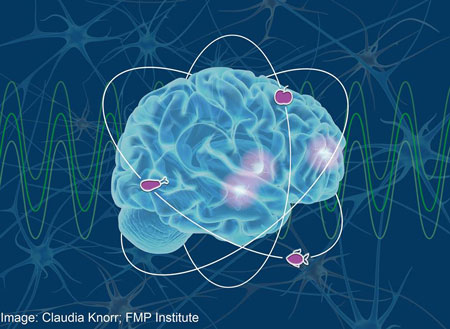Gamma oscillations - rhythmical waves of brain activity, occurring with 30-100 cycles per second, are well studied in cortical regions and are known to support major cognitive functions, including memory, attention and cognitive flexibility. These brain functions are crucial for successful food seeking. However, it was not known whether and how fast signaling, mediated by gamma oscillations, regulates feeding behaviors. The lateral hypothalamus (LH) is essential for the regulation of feeding. Neurons in the LH respond to metabolic signals, including glucose and leptin, and are connected to multiple brain regions. However, it remained elusive whether and how the hypothalamus responds to top-down oscillatory fast signaling. We found prominent gamma oscillations in the LH and its major gateway - lateral septum. Remarkably, these oscillations were behavior-dependent: their power increased as a mouse approached food. To study whether gamma oscillations are causally related to food-seeking, we activated the top-down pathway from lateral septum to the LH at gamma frequency using optogenetics - a technique that allows to selectively control the activity of a brain pathway by shining light on it. Indeed, this activation led to food approach, whereas inhibition of the same pathway precluded this behavior.

To study mechanisms of gamma-rhythmic signaling in the LH, we analyzed the activity of LH neurons during gamma oscillations. A subset of neurons in the LH exhibits preferential activity in proximity to the food location, while other LH cells are preferentially active distantly from the food location. Remarkably, gamma-rhythmic input from the lateral septum enabled separate signaling by these two functional subsets of LH neurons, making them fire at distinct phases of the gamma oscillation with millisecond precision.
Interestingly, increase of gamma power was confined to the food approach but not feeding itself. Accordingly, gamma-frequency activation of the lateral septum to lateral hypothalamus pathway affected food approach but not food intake: animals approached the food location also when they were not hungry, and did not consume more food than usual. This selective induction of food seeking without changes in food intake contrasts with an increased food intake during activation of a subset of cells in LH - Vgat-expressing cells. We found that the gamma-mediated fast top-down signaling also affected activity of functional subsets of LH cells, described above, on a longer (seconds) scale. While the food intake-increasing optogenetic activation of LH Vgat cells evoked a prominent increase in firing of cells which are active close to a food location, gamma-frequency optogenetic stimulation of inputs onto the LH from the lateral septum increased firing of LH cells which are active distantly from the food location. Thus, gamma-rhythmic signaling in the LS-LH pathway selectively regulates firing of functionally distinct LH cells at multiple time scales.
Upstream, we identified medial prefrontal cortex projections providing gamma-rhythmic inputs to the lateral septum. Gamma-rhythmic optogenetic activation of this pathway evoked spontaneous food seeking and led to improved performance in a food-rewarded learning task whereas inhibition of this pathway decreased both spontaneous food seeking and the task performance. These results suggest that activation of this pathway also assists in food seeking in cognitively demanding situations, when a mouse had to find food using previous experience.
Overall, our work identified a novel top-down pathway from medial prefrontal cortex via lateral septum to the lateral hypothalamus, which utilizes gamma synchronization to guide activity of subcortical networks and to regulate feeding behavior by dynamic reorganization of functional cell groups in the hypothalamus. A multidisciplinary, multinational cooperation of scientists from The Francis Crick Institute (UK), Stanford University (USA), and Tufts University (USA), which was possible due to the HFSP Young Investigator Grant funding, enabled organization and function of this pathway to be deciphered at multiple levels, from anatomical connections to excitability of individual cells, network mechanisms and behavioral role.
For more on this story see the press release from the Leibniz Institute for Molecular Pharmacology, Berlin, Germany.
Reference
Gamma oscillations organize top-down signaling to hypothalamus and enable food seeking. Carus-Cadavieco M*, Gorbati M*, Ye L, Bender F, van der Veldt S, Kosse C, Börgers C, Lee SY, Ramakrishnan C, Hu Y, Denisova N, Ramm F, Volitaki E, Burdakov D, Deisseroth K, Ponomarenko A*§, Korotkova T*§ (2017). Nature. 2017 542(7640):232-236. doi: 10.1038/nature21066.


































